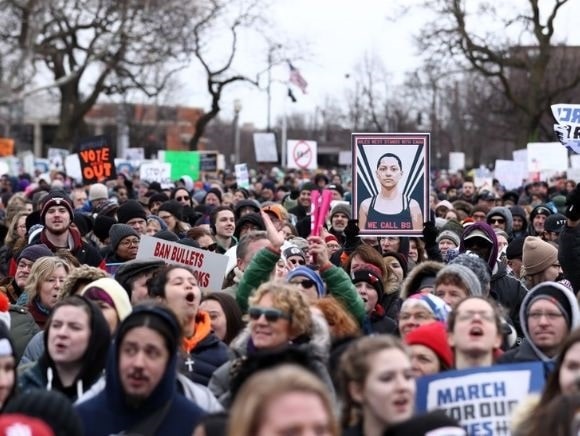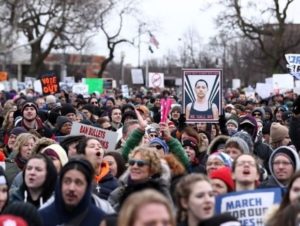
(Photo by Bilgin S. Sasmaz/Anadolu Agency/Getty Images)
Today gun control advocates will gather in Washington, DC, and 300 other smaller, local venues for the annual March for Our Lives. These people want to restrict the right to keep and bear arms and end what they call “gun glorification,” or “the belief embedded in our culture that power and safety are derived from guns.” Many are simply horrified by the violence dominating the 24-hour news cycle – as we all should be – while others are anti-gun with or without horrific events like the Uvalde massacre.
Noble as their intentions may be, however, they’re misinformed. Despite what’s posted on many a protest sign, gun laws do not save lives. Guns save lives. More specifically, armed defenders stop violent criminals. It sounds cliché, but yes, good guys with guns – be it officer or civilian – really are all that stops bad guys with guns.
Gun Control’s Embarrassing Record
 The 1960s saw 42 deaths and 42 injuries in 23 school shootings in the United States. Then, in the 1970s – right after the Gun Control Act of 1968 clamped down on the right to keep and bear arms – there were 39 killed and 79 injured during 41 school shootings. The 1980s were even worse.
The 1960s saw 42 deaths and 42 injuries in 23 school shootings in the United States. Then, in the 1970s – right after the Gun Control Act of 1968 clamped down on the right to keep and bear arms – there were 39 killed and 79 injured during 41 school shootings. The 1980s were even worse.
On May 16, 1986, former town marshal David Young and his wife, Doris, took 136 children and 18 adults hostage at the Cokeville Elementary School in Wyoming. Two deaths and 74 injuries are attributed to the shooting, but 73 of the injuries occurred after Doris accidentally detonated a bomb she was carrying. Just one of the injured was from gunfire, as David then killed his wife, shot and wounded a teacher, and finally committed suicide.
That story is relevant to the larger conversation because of the effect it has on the total calculation. The two dead were the perpetrators and all but one of the wounded were injured by an explosion rather than gunfire. With those casualties included, the 1980s saw 67 deaths and 188 injuries across 61 incidents – though the injured list drops to 115 without the bomb victims. And that does include the shooters if they’re killed or wounded on site, which does happen from time to time.
Then came the 1990s, the golden days of gun control. There’s the Brady Act and the infamous assault weapons ban, of course, but it all started in 1990 when schools became gun free zones. Finally, with firearms prohibited on school grounds, the youth of our nation would be safe.
There were 97 school shooting incidents that decade, which brought 106 deaths and 158 injuries.
The historical record of school shootings – and crime in general – doesn’t show that gun violence has fallen in the wake of gun control measures. It has increased. But why? Well, unlike the restrictions the left say we need, the answer really is common sense: Criminals, by definition, are willing to violate the law. Firearm restrictions don’t actually impede anyone but those who strive to obey the law – that is, the potential victims who need to be able to protect themselves from violent criminals but can’t because of government interference.
The March Against Self Defense
Let’s imagine, for a moment, that there’s a magic button. Once pressed, poof! No more firearms and no more knowledge of how to make them. Finally, we will be free from gun violence.
But we won’t be free from violence. Kain killed his brother, Abel, with a rock. People have been murdering each other with sticks, stones, knives, and a bevy of other instruments of death – some quite creative in design, in fact – just about as long as there have been people to kill. For that matter, someone drove a car into a crowd in Berlin just days ago, killing one and wounding nine others. That’s as many deaths as 36 and fewer than 42 – or, put differently, equal to or less than 78 – of the last 100 “mass shootings,” as defined and tracked by the Gun Violence Archive, which Mark Bryant and Michael Klein founded in 2013 to pick up where Slate left off.

(Photo by Bilgin S. Sasmaz/Anadolu Agency/Getty Images)
Yes, the car attack in Berlin was as deadly as, or deadlier than, 78% of recent mass shootings in the US. It also had more wounded and more total victims than 93 of those 100 shootings.
But back to our magical solution. We know violence comes not from the barrel of a gun, but from the person pulling the trigger. So, imagine a hypothetical situation in which you’re sitting at home eating supper with your family. A violent criminal bursts through the door. Maybe he’s there for your stuff, or maybe he’s there for you. He’s armed. You’re armed. So, get to your sword, draw your blade, and prepare to defend your household. Are you adequately trained in melee combat? Will you fare any better than the resident in the real world armed with a pistol or an AR-15 – even if the home invader also has a gun?
Training is essential for any weapon, but a firearm requires much less training than a sword or spear to achieve an adequate preparedness. And firearms have the added advantage of empowering both the novice and the physically inferior to at least have a chance at self-defense. A woman, child, or less muscular man who isn’t an expert with the blade is almost certainly doomed in the primitive version of our hypothetical – but we call guns the great equalizer for a reason.
Those marching “for our lives” may have noble intentions, but that doesn’t make them any less wrong. They aren’t marching for life; they’re marching against it. They’re demanding an end to the right to adequate self-defense in the face of extreme violence. Whether they realize it or not, they’re demanding victimhood.
Remember to check out the web’s best conservative news aggregator
Whatfinger.com — the #1 Alternative to the Drudge

